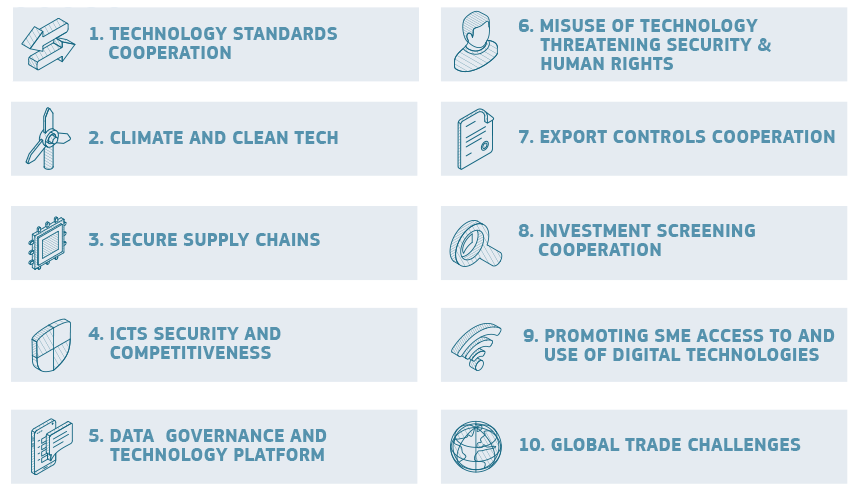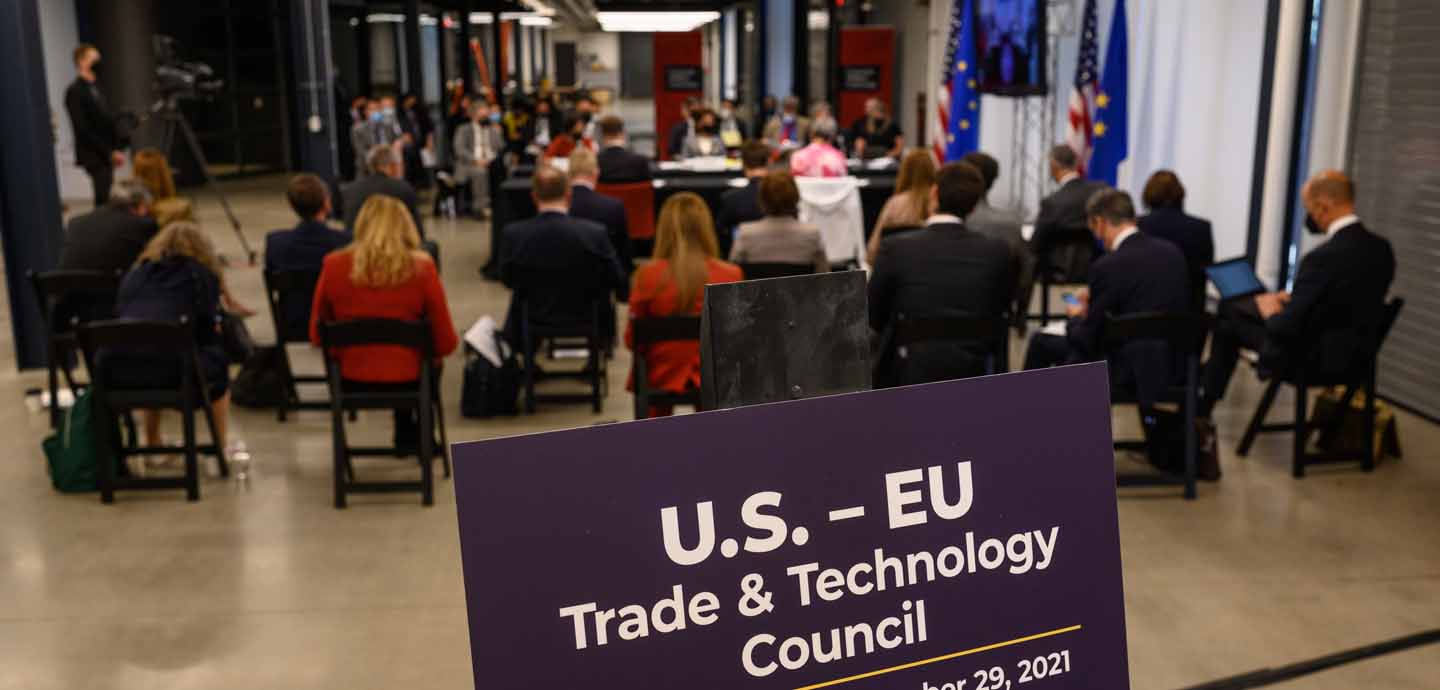The war in Ukraine has redesigned the forum that the European Union and the United States created in June 2021 to coordinate on key global issues of international trade and technology, the Trade and Technology Council (TTC). The effect of the conflict on global supply chains for critical gases and minerals in the semiconductor industry, the risk of a food crisis stemming from the lack of wheat crops’ exports produced in Ukraine, or the energy price war and its impact on the production of green technologies are some of the causes that knocked on the TTC’s door and led to a shift towards Ukraine.
If the dilemma at the first meeting, held in Pittsburgh in September 2021, was whether or not to target China during the negotiations and agreements -something that the United States proposed, but that the EU ruled out-, the results of the second meeting that took place just a few days ago in Paris-Saclay on 15 and 16 May show that targeted measures towards a third country have indeed permeated, in this case on Russia. Specifically, both sides agreed on export control mechanisms and a coordinated response to sanctions towards Russia.
Synergies between the European Union and United States at a two-fold level: political and implementation
This shift towards the war in Ukraine has translated into a number of clear and defined measures. Its most impactful deliverable has been the high level of coordination, almost unprecedented in recent years both at the highest spheres of political decision-making and across the ten Working Groups with officers and experts, if compared to Trump Administration’s mandate. During those years, the difficulty to move certain demands, needs or areas of cooperation up to the highest spheres of political influence in the chain was often raised during information conversations in Washington DC.
In the current landscape, it is not only the shift to a new Biden-Harris administration that has restored the US’s vision of greater collaboration with the EU. Also, the setting-up of a community with regular meetings in a fixed and sustained dialogue space such as the TTC, and in ten Working Groups with a line-up of highly specialised experts and officers, has generated links of understanding and more direct communication between them, both at the levels of political decision-making and of execution and implementation.

This explains why a number of agreements have been reached between the US and the EU on all issues, although they are so far mostly oriented towards information sharing and joint mapping, rather than executive issues. One of the most notable outcomes is the Strategic Standardisation Information Mechanism, which seeks to promote and defend common interests in the negotiation of critical standards at the international level. It is expected to receive further details on other agreements, such as the proposal to increase semiconductors demand transparency and avoid “subsidy races”. This term began to be heard intensively after the announcement of the proposal on a European Chips Act, which aims to ease state aid rules. These rules seek to prevent illegal and unfair subsidies granted by countries to companies. With the Chips Act, the idea is to adapt these rules, under strict conditions, to support the creation of “first-of-its-kind” European production, as long as the aid is proportionate, necessary and has a measurable pan-European impact. As the TTC embraces issues still under development, it will be necessary to monitor both the European and the TTC proposals at the same time.
Challenges ahead for the Trade and Technology Council (TTC)
US Trade Representative, Katherine Tai, summed up during the in-person stakeholders’ meeting the main outcome of the second meeting: “Good work and results: the reward for that is more work, and more results.” A number of challenges arise.
First, in the long term: the survival and sustainability of the TTC in view of possible political changes. The year 2024 is as far away as near. In the EU, European Parliament’s elections will be held. The first term of Ursula Von der Leyen and her team at the European Commission will come to an end, barring a renewal. In the US, Presidential elections will be held at a time where it is unclear which candidate will run for the Democratic Party -either Joe Biden or other candidates, although it is likely that the party will keep its political vision. Also, it remains unknown whether or not Trump will run again as a candidate for the Republican Party, whose sign is being regenerated during these years. Today, the TTC relies on two pillars: that of the high political level and that of civil servants and experts who make up each of the ten Working Groups. Both will be relevant, but should the former suffer at some point, the role of the civil service will be key. To this end, the existing working groups and the sub-groups that are being set up over time should acquire a higher degree of institutionalisation and autonomy in case of possible setbacks.
Second, in the short term: it will be important to keep the Ukraine issue on the agenda, but other pressing issues must remain on the horizon. This is the case of support for SMEs in the use of digital technologies, or joint coordination on practical guidelines to improve companies’ cyber maturity.
Third, the TTC would benefit from increasing the work it has already started vis-à-vis joint responses at crisis situations. It has already announced the creation of a cooperative framework to ensure information integrity in crisis scenarios in the Technology Platforms Working Group; or the commitment to develop a joint analytical framework to identify foreign information manipulation or interference. The next step should be to move from joint risk identification to executive responses to such risks – to Ukraine, but also to other global security issues.
Fourth, the TTC is of relevance to EU member states. While main stakeholders involved in the TTC are US and EU officials as well as European-wide industry associations, the impact of the TTC at the national level is clear. Hence, it is important for the public administration to monitor negotiations and measure the effect of agreements on their respective country’s interests and needs. Just to give an example, the PERTE (Strategic Project for the Economic Recovery and Transformation) for microelectronics and semiconductors approved by the Spanish government in May 2022, with an investment of 12.25 billion euros, aims to have a comprehensive approach, both in the R&D phase, as well as in design and manufacturing. The First Vice-President of Spain acknowledged the lack of a coherent strategy and resources so far. With the announcement of this PERTE, there is an opportunity for a Member State: hence, the momentum to follow up the TTC agenda, increase inter-ministerial coordination and seek to influence actors involved.
General view of the inaugural meeting of the United States-European Union Trade and Technology Council (TTC) in Pittsburgh (21/09/2021). Photo: Justin Merriman / EC – Audiovisual Service, © European Union, 2021.



